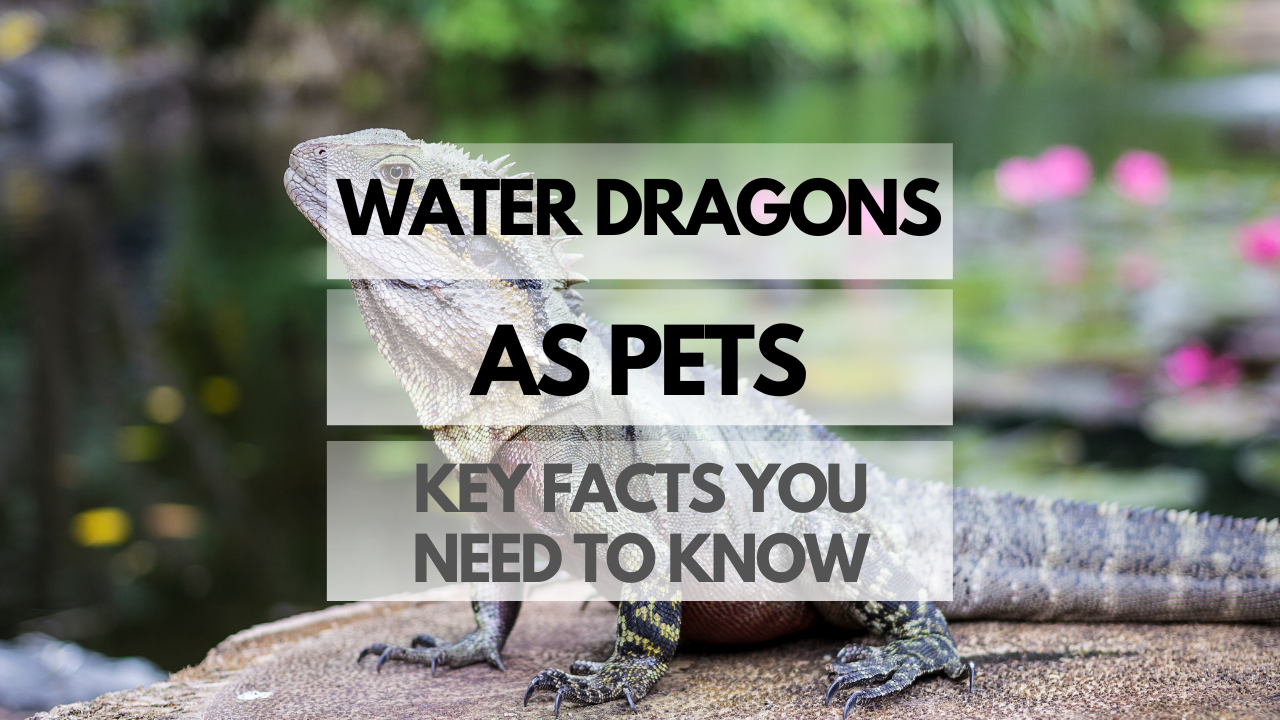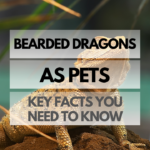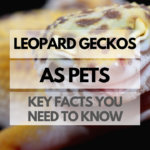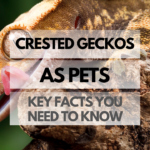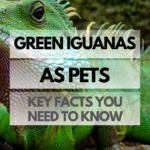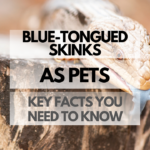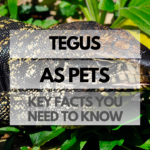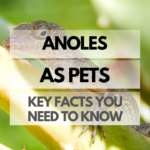Water Dragons, also known as Chinese and Australian Water Dragons, are fascinating reptiles originating from Asia and Australia. Their striking appearance, curious nature, and unique behaviors have made them increasingly popular pets among reptile enthusiasts. In this article, we’ll explore everything you need to know about keeping Water Dragons as pets.
Quick Reference Table: Water Dragon Facts
| Fact | Description |
|---|---|
| Scientific Name | Chinese: Physignathus cocincinus Australian: Intellagama lesueurii |
| Size | 2-3 feet (including tail) |
| Lifespan | 10-15 years |
| Diet | Omnivorous |
| Temperament | Docile, curious, can be shy |
| Native Habitat | Asia and Australia |
How Are Water Dragons as Pets?
Water Dragons can make rewarding and captivating pets for committed and experienced reptile keepers. They have unique needs and require specialized care, but with proper attention and a suitable environment, they can thrive in captivity.
Pros and Cons of Water Dragons
Pros: Water Dragons are visually stunning, with vibrant colors and striking features. They are generally docile and curious, making them interesting pets to observe and interact with. They are also quite hardy and can tolerate a range of conditions.
Cons: Water Dragons require a spacious enclosure with specialized equipment, which can be costly. They also need a varied diet, and some individuals may be shy or skittish, requiring patience and gentle handling.
Water Dragon Behavior and Temperament
Water Dragons are curious and intelligent reptiles with a generally docile temperament. They can be shy and may take time to become comfortable with their environment and owner. Regular, gentle handling and a calm environment can help them become more social and interactive pets.
How Much Do Water Dragons Cost?
The initial cost of a Water Dragon can range from $50 to $200, depending on factors such as age, size, and coloration. Additional costs include a suitable enclosure, specialized equipment, and ongoing expenses such as food, substrate, and electricity.
Water Dragon Lifespan: Time and Commitment
With proper care, Water Dragons can live for 10-15 years in captivity. Before investing in a Water Dragon as a pet, consider the long-term commitment required, including the time needed for daily care, habitat maintenance, and regular health checks.
Water Dragon Size
Water Dragons typically grow to a length of 2-3 feet, including their long, prehensile tails. They require a spacious enclosure to accommodate their size and arboreal nature.
Water Dragon Species
Chinese Water Dragon (Physignathus cocincinus)
Native to Southeast Asia, the Chinese Water Dragon is known for its vibrant green coloration, crested head, and long, slender tail. They are semi-arboreal and thrive in a tropical environment with access to water.
Australian Water Dragon (Intellagama lesueurii)
Found in eastern Australia, the Australian Water Dragon sports a mix of green and brown hues, with striking markings and a robust build. They inhabit forests near water sources and can adapt to a variety of climates.
Water Dragon Colors, Looks and Appearances
Water Dragons are visually stunning reptiles, with vibrant green or brown coloration, distinctive crests on their heads, and long, prehensile tails. Their striking appearance, combined with their curious and intelligent nature, makes them fascinating pets to observe and care for.
Water Dragon Care Guide
Proper care is essential for the health and well-being of your Water Dragon. This includes providing a suitable habitat, a balanced diet, and regular health checks.
Water Dragon Habitat: Tank and Housing
Appropriate Water Dragon Tank SizeAdult Water Dragons require a spacious enclosure, with a minimum size of 4 feet long, 2 feet wide, and 4 feet tall. This allows them to climb, explore, and swim as they would in the wild.
Types of Enclosures
Glass or PVC enclosures with a mesh top are suitable for Water Dragons, as they offer good visibility and ventilation. Ensure the enclosure has secure locks to prevent escapes.
Substrate Options
Choose a substrate that retains moisture, such as coconut coir, cypress mulch, or a mix of peat moss and orchid bark. This will help maintain humidity and allow your Water Dragon to burrow.
Heating and Lighting Requirements
Provide a basking spot with a temperature of 90-95°F and a cooler area around 75-85°F. Use a heat lamp and a ceramic heat emitter to maintain these temperatures. Also, supply UVB lighting to support proper calcium absorption and overall health.
Humidity and Temperature Control
Water Dragons require a humidity level of 60-80%. Use a hygrometer to monitor humidity, and mist the enclosure daily or use a humidifier to maintain appropriate levels. Regularly check temperatures with a digital thermometer.
Furnishings and Decorations
Include branches, vines, and sturdy plants for climbing, as well as a large water area for swimming. Provide hiding spots, such as cork bark, for your Water Dragon to retreat to when stressed or seeking solitude.
Cleaning and Maintenance
Spot-clean the enclosure daily by removing waste and uneaten food. Deep-clean and replace the substrate every 4-6 weeks, or more frequently if needed. Clean and disinfect the water area regularly to prevent bacterial growth.
Water Dragon Food: Diet and Nutrition
Feeding Frequency and Schedule
Feed juvenile Water Dragons daily, and adults every other day. Adjust the frequency and portion size as needed to maintain a healthy weight.
What do Water Dragons Eat?
Water Dragons are omnivorous and require a varied diet of insects, such as crickets, mealworms, and roaches, as well as vegetables and fruits, like collard greens, dandelion greens, and berries.
Water Dragon Treats
Occasionally offer treats like waxworms, hornworms, or small feeder fish to add variety to your Water Dragon’s diet.
Foods to Avoid
Avoid feeding your Water Dragon avocado, rhubarb, or iceberg lettuce, as these can be harmful or lack nutritional value.
Supplements and Vitamins
Dust insects with calcium powder 4-5 times per week and a multivitamin supplement once per week to ensure proper nutrition.
Hydration
Provide a large water area for your Water Dragon to drink from and swim in. Mist the enclosure daily to maintain humidity and encourage natural drinking behaviors.
Handling and Socialization
Taming and Bonding
Begin taming and bonding with your Water Dragon by spending time near their enclosure and speaking softly to them. Once they’re comfortable with your presence, gradually introduce gentle handling. Offer treats to create positive associations and build trust.
Safe Handling Techniques
When handling your Water Dragon, support their body with one hand, while gently cradling their head with the other. Avoid sudden movements and always wash your hands before and after handling to prevent the spread of bacteria and parasites.
Signs of Stress and Illness
Monitor your Water Dragon for signs of stress or illness, such as lethargy, loss of appetite, or changes in behavior. If you notice any concerning symptoms, consult a reptile veterinarian for advice and treatment.
Introducing Water Dragons to Other Pets
Introducing Water Dragons to other pets should be done with caution, as they may not be compatible with other species. If you must house them with other reptiles, ensure they have plenty of space and hiding spots to minimize stress and aggression.
Health and Wellness
Common Health Issues
Water Dragons can suffer from various health issues, such as metabolic bone disease, respiratory infections, and parasites. Providing a proper diet, clean environment, and appropriate humidity and temperature levels can help prevent these issues.
Signs of a Healthy Water Dragon
A healthy Water Dragon will have clear eyes, smooth skin, a strong grip, and a good appetite. They should be alert, active, and responsive to their environment.
Preventative Care
Regularly check your Water Dragon’s enclosure for any hazards and maintain a clean, well-ventilated environment. Offer a balanced diet and maintain proper temperature and humidity levels to prevent health issues.
Finding a Reptile Veterinarian
Locate a reptile veterinarian experienced with Water Dragons to provide regular check-ups and address any health concerns. Establishing a relationship with a knowledgeable vet is essential for the long-term health of your pet.
Breeding and Reproduction
Determining Gender
Male Water Dragons typically have larger heads, broader jowls, and enlarged femoral pores compared to females. Females have slimmer bodies and less pronounced crests on their heads.
Mating Behavior and Courtship
Water Dragons display unique courtship behaviors, such as head bobbing, arm waving, and tail twitching. Males may also chase and bite females to initiate mating.
Gravidity and Egg-laying
Gravid female Water Dragons will seek a suitable nesting site to lay their eggs, typically in a moist, well-drained substrate. Provide a nesting box with suitable materials to accommodate this natural behavior.
Incubation and Hatching
Water Dragon eggs require an incubation period of approximately 60-90 days at a temperature of 82-86°F. Once hatched, the baby Water Dragons will be independent and require similar care to adults, with adjustments for their size and dietary needs.
Caring for Hatchlings
Provide hatchling Water Dragons with a smaller enclosure, appropriate temperature gradients, and a diet of small insects and finely chopped fruits and vegetables. Monitor their growth and development closely to ensure they’re thriving.
Are Water Dragons Legal?
Water Dragon legality varies by location, so check with your local authorities or wildlife department to determine if they’re allowed as pets in your area. Some regions may require permits or have specific regulations regarding their care and housing.
Popular Names for Water Dragons
Here’s a list of fun and interesting names for your Water Dragon:
- Draco
- Aqua
- Emerald
- Hydra
- River
- Willow
- Nessie
- Waverly
- Merlin
- Jade
Conclusion: Should You Own Water Dragons as Pets?
Water Dragons can make captivating and rewarding pets for dedicated and experienced reptile enthusiasts. Their unique appearance and fascinating behaviors provide endless entertainment and enjoyment. However, it’s essential to understand the commitment and responsibility involved in their care. Withproper attention to their needs, Water Dragons can thrive and become a cherished addition to your family. Remember to always practice responsible ownership and consult with a reptile veterinarian for guidance on your Water Dragon’s health and well-being.
FAQ for Pet Water Dragons
- Q: Are Water Dragons good pets?
- A: Water Dragons can be good pets for experienced reptile enthusiasts who are committed to providing proper care and attention to their needs.
- Q: Can Water Dragons eat grapes?
- A: Yes, Water Dragons can eat grapes in moderation as an occasional treat.
- Q: Can Water Dragons eat bananas?
- A: Yes, Water Dragons can eat bananas in moderation as part of a varied diet.
- Q: Can Water Dragons eat strawberries?
- A: Yes, Water Dragons can eat strawberries as an occasional treat.
- Q: Can Water Dragons eat apples?
- A: Yes, Water Dragons can eat apples as part of a varied diet. Be sure to remove the seeds before feeding.
- Q: Can Water Dragons eat spinach?
- A: Spinach should be fed sparingly to Water Dragons due to its high oxalate content, which can interfere with calcium absorption.
- Q: Can Water Dragons eat tomatoes?
- A: Tomatoes can be fed occasionally to Water Dragons, as they are high in water content and can provide hydration.
- Q: Can Water Dragons eat carrots?
- A: Yes, Water Dragons can eat carrots, preferably shredded or finely chopped, as part of a varied diet.
- Q: Can Water Dragons eat cucumbers?
- A: Yes, Water Dragons can eat cucumbers in moderation as part of a varied diet.
- Q: Can Water Dragons eat watermelon?
- A: Yes, Water Dragons can eat watermelon as an occasional treat due to its high water content.
- Q: Can Water Dragons eat broccoli?
- A: Yes, Water Dragons can eat small amounts of broccoli as part of a varied diet.
- Q: Can Water Dragons eat blueberries?
- A: Yes, Water Dragons can eat blueberries as an occasional treat.
- Q: Can Water Dragons eat celery?
- A: Yes, Water Dragons can eat small amounts of finely chopped celery as part of a varied diet.
- Q: Can Water Dragons eat cabbage?
- A: Water Dragons can eat small amounts of cabbage as part of a varied diet, but it should not be a staple food item.
- Q: Can Water Dragons eat cilantro?
- A: Yes, Water Dragons can eat small amounts of cilantro as part of a varied diet.
- Q: Can Water Dragons eat kale?
- A: Yes, Water Dragons can eat kale as part of a varied diet, but it should be fed in moderation due to its high oxalate content.
- Q: Can Water Dragons eat blackberries?
- A: Yes, Water Dragons can eat blackberries as an occasional treat.
- Q: Can Water Dragons eat oranges?
- A: Oranges can be fed sparingly to Water Dragons due to their high acidity, which can cause digestive issues in large amounts.
- Q: Can Water Dragons eat avocados?
- A: No, avocados should not be fed to Water Dragons, as they contain persin, which can be toxic to reptiles.
- Q: Can Water Dragons eat corn?
- A: Yes, Water Dragons can eat corn as part of a varied diet.
- Q: Can Water Dragons eat asparagus?
- A: Yes, Water Dragons can eat small amounts of asparagus as part of a varied diet.
- Q: How often do Water Dragons eat?
- A: Adult Water Dragons typically eat every other day, while juveniles may eat daily.
- Q: How long do Water Dragons live?
- A: Water Dragons can live up to 10-15 years in captivity with proper care.
- Q: Where are Water Dragons native?
- A: Water Dragons are native to Southeast Asia, including regions of Thailand, Vietnam, and Cambodia.
- Q: Are Water Dragons friendly?
- A: Water Dragons can be friendly and docilewith proper handling and socialization. However, they may be shy and skittish at first and will require patience and time to build trust.
- Q: Do Water Dragons bite?
- A: Water Dragons can bite if they feel threatened or stressed, but with proper handling and socialization, the risk of biting can be minimized.
- Q: Do Water Dragons like to be held?
- A: Some Water Dragons may tolerate or even enjoy being held, while others may be more skittish. Building trust through gentle and consistent handling can help improve their comfort level with being held.
- Q: Are Water Dragons nocturnal?
- A: Water Dragons are diurnal, meaning they are active during the day and sleep at night.
- Q: Do Water Dragons pee?
- A: Yes, Water Dragons excrete waste through urates, which resemble white, chalky deposits. They also excrete solid waste in addition to urates.
- Q: Do Water Dragons hibernate?
- A: Water Dragons do not hibernate, but they may become less active during cooler months or when temperatures drop in their environment.
- Q: Do Water Dragons make noise?
- A: Water Dragons are generally quiet pets, but they can make hissing sounds when threatened or stressed.
- Q: Are Water Dragons venomous or poisonous?
- A: Water Dragons are neither venomous nor poisonous and are considered safe pets when handled properly.
- Q: Are Water Dragons smart?
- A: Water Dragons are considered intelligent reptiles, capable of learning and adapting to their environment and responding to their caretakers.
- Q: Do Water Dragons need heat at night?
- A: Water Dragons require a temperature gradient in their enclosure, with a cooler area for nighttime. A slight drop in temperature at night is natural and beneficial for their health, but the temperature should never drop below 65°F (18°C).
- Q: Do Water Dragons lay eggs?
- A: Yes, female Water Dragons lay eggs, usually in a burrow or nest that they dig in the substrate.
- Q: Do Water Dragons smell?
- A: Water Dragons themselves do not have a strong odor, but their enclosures can develop unpleasant smells if not cleaned regularly. Proper hygiene and maintenance of their habitat can help minimize odors.

